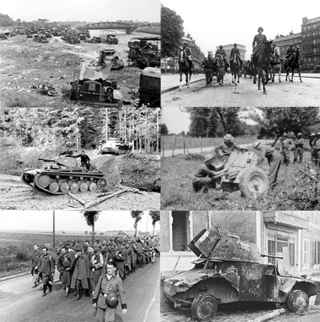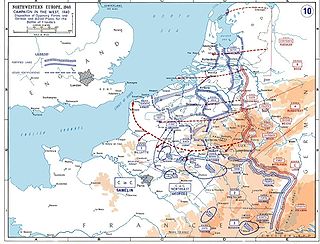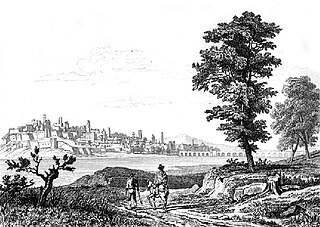
Limburg, also known as Belgian Limburg, is a province in Belgium. It is the easternmost of the five Dutch-speaking provinces that together form the Region of Flanders, which is one of the three main political and cultural sub-divisions of modern-day Belgium. As of January 2024, Limburg had a population of 0.9 million.

The Battle of Fleurus, on 26 June 1794, was an engagement during the War of the First Coalition, between the army of the First French Republic, under General Jean-Baptiste Jourdan, and the Coalition army, commanded by Prince Josias of Coburg, in the most significant battle of the Flanders Campaign in the Low Countries during the French Revolutionary Wars. Both sides had forces in the area of around 80,000 men but the French were able to concentrate their troops and defeat the First Coalition. The Allied defeat led to the permanent loss of the Austrian Netherlands and to the destruction of the Dutch Republic. The battle marked a turning point for the French army, which remained ascendant for the rest of the War of the First Coalition.

The Battle of Aldenhoven or Battle of the Roer saw a Republican French army commanded by Jean Baptiste Jourdan defeat a Habsburg army under François Sébastien Charles Joseph de Croix, Count of Clerfayt which was defending the line of the Roer River. A key crossing was won by the French right wing at Düren after heavy fighting. The Austrian retreat from the Roer conceded control of the west bank of the Rhine River to France. The battle occurred during the War of the First Coalition, part of a wider conflict called the Wars of the French Revolution. Aldenhoven is located in the state of North Rhine-Westphalia in Germany about 21 kilometres northeast of Aachen.

The Battle of France, also known as the Western Campaign, the French Campaign and the Fall of France, during the Second World War was the German invasion of the Low Countries and France. The invasion plan for the Low Countries and France was called Case Yellow. Fall Rot was planned to finish off the French and British after the evacuation at Dunkirk. The Low Countries and France were defeated and occupied by Axis troops down to the Demarcation line. In November 1942, Wehrmacht troops also occupied Vichy France ending land operations on the Western Front until the Normandy landings began on 6 June 1944.

The siege of Antwerp was an engagement between the German and the Belgian, British and French armies around the fortified city of Antwerp during the First World War. German troops besieged a garrison of Belgian fortress troops, the Belgian field army and the British Royal Naval Division in the Antwerp area, after the German invasion of Belgium in August 1914. The city, which was ringed by forts known as the National Redoubt, was besieged to the south and east by German forces.

The Battle of Liège was the opening engagement of the German invasion of Belgium and the first battle of the First World War. The city of Liège was protected by a ring of modern fortresses, one of several fortified cities to delay an invasion to allow troops from the powers which had guaranteed Belgian neutrality to assist the Belgian Army in the expulsion of the invaders.

The Battle of the Frontiers comprised battles fought along the eastern frontier of France and in southern Belgium, shortly after the outbreak of the First World War. The battles resolved the military strategies of the French Chief of Staff General Joseph Joffre with Plan XVII and an offensive adaptation of the German Aufmarsch II deployment plan by Helmuth von Moltke the Younger. The German concentration on the right (northern) flank, was to wheel through Belgium and attack the French in the rear.

The Great Retreat, also known as the retreat from Mons, was the long withdrawal to the River Marne in August and September 1914 by the British Expeditionary Force (BEF) and the French Fifth Army. The Franco-British forces on the Western Front in the First World War had been defeated by the armies of the German Empire at the Battle of Charleroi and the Battle of Mons. A counter-offensive by the Fifth Army, with some assistance from the BEF, at the First Battle of Guise failed to end the German advance and the retreat continued over the Marne. From 5 to 12 September, the First Battle of the Marne ended the Allied retreat and forced the German armies to retire towards the Aisne River and to fight the First Battle of the Aisne (13–28 September). Reciprocal attempts to outflank the opposing armies to the north known as the Race to the Sea followed from (17 September to 17 October).

The German invasion of the Netherlands, otherwise known as the Battle of the Netherlands, was a military campaign, part of Case Yellow, the Nazi German invasion of the Low Countries and France during World War II. The battle lasted from 10 May 1940 until the surrender of the main Dutch forces on 14 May. Dutch troops in the province of Zealand continued to resist the Wehrmacht until 17 May, when Germany completed its occupation of the whole country.

The Battle of Halen, also known as the Battle of the Silver Helmets because of the many cavalry helmets left behind on the battlefield by the German cuirassiers, took place on 12 August 1914 at the beginning of the First World War, between German forces led by Georg von der Marwitz and Belgian troops led by Léon De Witte. The name of the battle alludes to the Battle of the Golden Spurs in 1302, where 500 pairs of golden spurs were recovered from the battlefield. Halen was a small market town and a convenient river crossing of the Gete and was situated on the principal axis of advance of the Imperial German army. The battle was a Belgian tactical victory, but did little to delay the German invasion of Belgium.

The ten days' campaign was a failed military expedition by the United Kingdom of the Netherlands against the secessionist Kingdom of Belgium between 2 and 12 August 1831. The campaign was an attempt by the Dutch King William I to halt the course of the Belgian Revolution which had broken out in August 1830.

The Dyle plan or Plan D was the plan of the commander-in-chief of the French Army, Général d'armée Maurice Gamelin, to defeat a German attempt to invade France through Belgium. The Dyle (Dijle) river is 86 km (53 mi) long, from Houtain-le-Val through Flemish Brabant and Antwerp; Gamelin intended French, British and Belgian troops to halt a German invasion force along the line of the river. The Franco-Belgian Accord of 1920 had co-ordinated communication and fortification efforts of both armies. After the German Remilitarization of the Rhineland on 7 March 1936, the Belgian government abrogated the accord and substituted a policy of strict neutrality, now that the German Army was on the German–Belgian border.

The Battle of the Gebora took place during the Peninsular War between Spanish and French armies on 19 February 1811, northwest of Badajoz, Spain. An outnumbered French force routed and nearly destroyed the Spanish Army of Extremadura.
The Battle of Hannut was a Second World War battle fought during the Battle of Belgium which took place between 12 and 14 May 1940 at Hannut in Belgium. It was the largest tank battle in the campaign. It was also the largest clash of tanks in armoured warfare history at the time.

The Low Countries theatre of the War of the First Coalition, also known as the Flanders campaign, was a series of campaigns in the Low Countries conducted from 20 April 1792 to 7 June 1795 during the first years of the War of the First Coalition. As the French Revolution radicalised, the revolutionary National Convention and its predecessors broke the Catholic Church's power (1790), abolished the monarchy (1792) and even executed the deposed king Louis XVI of France (1793), vying to spread the Revolution beyond the new French Republic's borders, by violent means if necessary. The First Coalition, an alliance of reactionary states representing the Ancien Régime in Central and Western Europe – Habsburg Austria, Prussia, Great Britain, the Dutch Republic, Hanover and Hesse-Kassel – mobilised military forces along all the French frontiers, threatening to invade Revolutionary France and violently restore the monarchy. The subsequent combat operations along the French borders with the Low Countries and Germany became the primary theatre of the War of the First Coalition until March 1796, when Napoleon took over French command on the Italian front.

The invasion of Belgium or Belgian campaign, often referred to within Belgium as the 18 Days' Campaign, formed part of the larger Battle of France, an offensive campaign by Germany during the Second World War. It took place over 18 days in May 1940 and ended with the German occupation of Belgium following the surrender of the Belgian Army.

The Battle of Sprimont, or Battle of the Ourthe, was a battle during the War of the First Coalition between a corps of the French revolutionary Army of Sambre-and-Meuse under General Jean-Baptiste Jourdan, and the left wing of an Austrian army under the François Sebastien Charles Joseph de Croix, Count of Clerfayt. The battle was fought to outflank and force the Austrian army away from their defensive line on the Meuse river, and was a French victory.

The siege of Namur was a battle between Belgian and German forces around the fortified city of Namur during the First World War. Namur was defended by a ring of modern fortresses, known as the Fortified Position of Namur and guarded by the 4th Division of the Belgian Army. The purpose of the fortified Belgian cities was to delay an invasion force until troops from the states guaranteeing Belgian independence came to their aid. The French Fifth Army planned to counter-attack while the Germans were besieging Namur.

The Battle of Lambusart saw a Republican French army led by Jean Baptiste Jourdan try to cross the Sambre River against a combined Dutch and Habsburg Austrian army under William VI, Hereditary Prince of Orange. This battle was the culmination of the fourth of five attempts to consolidate a foothold on the north side of the Sambre. The clash occurred during the War of the First Coalition, part of a wider struggle known as the Wars of the French Revolution. In 1794, Lambusart was an independent village, but it is now part of the Fleurus municipality. Lambusart is located about 10 kilometres (6 mi) northeast of Charleroi.

The Battle of Dinant was an engagement fought by French and German forces in and around the Belgian town of Dinant in the First World War, during the German invasion of Belgium. The French Fifth Army and the British Expeditionary Force (BEF) advanced into Belgium and fought the Battle of Charleroi (21–23 August) and Battle of Mons (23 August), from the Meuse crossings in the east, to Mons in the west. On 15 August 1914, German troops captured the Citadel of Dinant which overlooked the town; the citadel was recaptured by a French counter-attack during the afternoon.



















